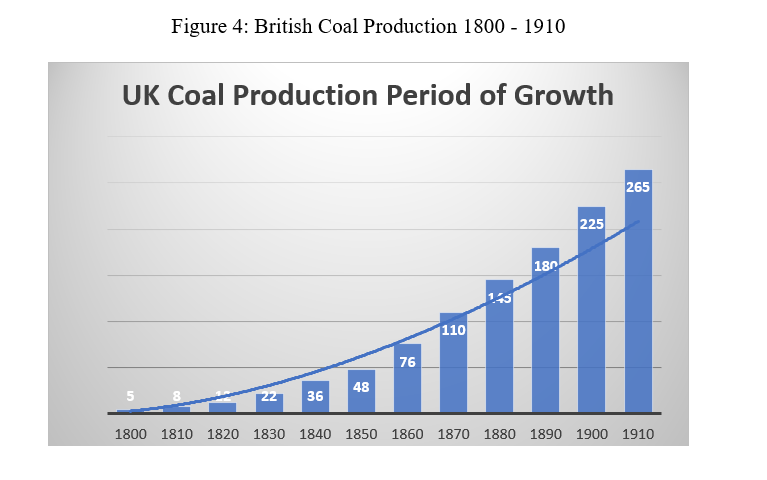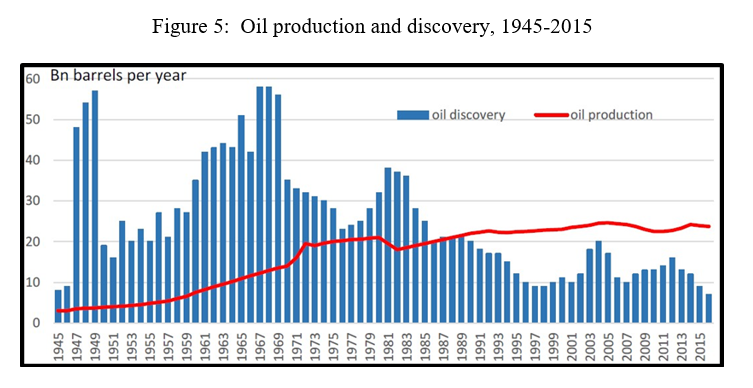In consideration of the global energy mix, it is useful to think about three distinct periods of energy use in human history.
Period 1: Pre-industrial revolution: In this period energy use can only occur on small scales and the primary source of energy is wood. The energy content of wood is about 1/2 that of coal and so a reasonable amount of wood can easily provide enough energy for the heating and cooking needs of a small area. The lower energy content in wood is primarily the result of a) wood is less dense than coal and b) wood usually contains a lot of water so energy derived from wood also turns water into steam. Note also that the renewable nature of wood occurs over a time scale of 30--50 years, which is relatively long compared to the growing demand for energy from historical human populations. Thus, wood has been effectively harvested (mined), which would ultimately have resulted in a depletion of that resource, if substitutes were not eventually discovered.
Period 2: The Fossil Fuel Era: Coal and peat lying on the surface of the Earth has long been used by various civilizations on small scales as a traditional fuel. The largest scale use will occur where the resource was most easily accessible and that appears to be in peat bogs near Hadrian's Wall in Roman Britain. Shaft mining of underground coal resources began in the late 18th century to access coal deposits that were 200--300 feet below the surface. As techniques were developed to mine even deeper resources, the production of coal in Britain rapidly increased (see Figure 4) and larger scale applications of coal energy would emerge which in turn requires more coal. This kind of feedback is what produces non-linear growth and ultimately resource exhaustion. This non-linear growth can be seen in Figure 1 as UK coal production ramps up to its peak production in 1910. The indicated values are in millions of tons per year and the fitted line is a power law with exponent = 1.75. Such rapid growth is generally propelled by new needs that have emerged. In this case a) coal became cheaper than wood in the 18th century in the UK due to dwindling supplies of wood and b) the steam engine was rapidly increasing penetration into everyday life.

However, the Fossil Fuel era doesn't really accelerate until the discovery of liquid crude oil in 1859 outside to Titusville PA, USA. Here now is energy in liquid form which is far easier to transport than energy in solid form (e.g. coal). Herein lays the key point about Fossil Fuels: while there energy content is only twice that of wood, the concentration of energy of accessible energy makes harvesting this resource very efficient and therefore this resource is rapidly exploited to become the dominant energy source for the planet. For example, a typical oil rig can now process about 10,000 barrels of oil per day. This represents about 1.3 million kg of fuel material per day. Since the energy density in oil is about 4 times that in wood, the daily production of the typical oil rig has an equivalent wood mass of 5.2 million kg. If a standard harvested tree for wood as a fuel source weighs 0.5 tonne, then about 10,000 trees per day would need to be harvested to match the daily output of the typical oil rig. Indeed, by 1800, the entire surface area of Britain would have to be harvested each year to meet its energy demands.
Such rapid exploitation leads to rapid exhaustion and a very narrow time window of just 200 years until exhaustion of global fuels. This situation was observed and documented by Hubbert (1956) to produce what is known as Hubbert's Peak. Hubbert assumed that consumption followed production based, on exponentially increasing consumption. This methodology shows that there is a unique depletion curve mathematically expressed as

To define the depletion time scale (Te) of a resource where k is the exponential growth rate of
consumption and R/ro is the ratio of reserves to production, starting in some year. Hubbert measured k =0.03 over an 8-year period starting in 1946 at which time R/ro was 120. The peak year is 1/2 and Hubbert's method predicted 1971 as the peak production time. No one believed this result at the time it was produced but future data complete vindicated Hubbert. This is the nature of resource depletion. When a resource is initially discovered and proves to be useful consumption starts to escalate. At some point in the future, usually after the time of peak resource usage, scarcity will cause price corrections which will extend the depletion time to longer times but, of course, at much lower production levels.
Period 3: The Future --Wholesale Substitution for Fossil Fuels: While there is debate about the future time when the fossil fuel resource will significantly decline, this is a finite resource and oil production is now about twice as high as discovery of new, conventional oil sources as seen in Figure 5. Maintaining the fossil fuel era then requires the discovery of unconventional sources of oil. Accessing these sources generally requires new forms of infrastructure which adds overall costs. Thus, while these unconventional sources may extend our use window by a few decades, it nevertheless seems clear that we are now at the end of cheap oil. This situation is well summarized in the IEA world oil production scenario as shown in Figure 6. Figure 6 makes it clear that a) crude oil production is now in the era of decline b) non-conventional sources (shale oil) need to rapidly grow to 10 MBD of production and c) that natural gas to liquids production must grow to 20-25 MBD over the next 10-15 years. To achieve these goals requires significant global investment into what is still a finite, dwindling resource. The alternative to this approach is to invest in renewable energies as an increasingly large share of the world's energy portfolio.


|